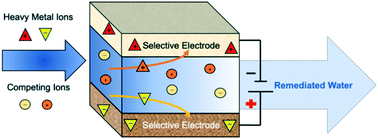Capacitive deionization and electrosorption for heavy metal removal
Abstract
Capacitive deionization (CDI) technologies have gained intense attention for water purification and desalination in recent years. Inexpensive and widely available porous carbon materials have enabled the fast growth of electrosorption research, highlighting the promise of CDI as a potentially cost-effective technology to remove ions. Whereas the main focus of CDI has been on bulk desalination, there has been a recent shift towards electrosorption for selective ion separations. Heavy metals are pollutants that can have severe health impacts and are present in both industrial wastewater and groundwater leachates. Heavy metal ions, such as chromium, cadmium, or arsenic, are of great concern to traditional treatment technologies, due to their low concentration and the presence of competing species. The modification/functionalization of porous carbon and recent developments of faradaic and redox-active materials have offered a new avenue for selective ion-binding of heavy metal contaminants. Here, we review the progress in electrosorptive technologies for heavy metal separations. We provide an overview of the wide applicability of carbon-based electrodes for heavy metal removal. In parallel, we highlight the trend toward modification of carbon materials, new developments in faradaic interfaces, and the underlying physico-chemical mechanisms that promote selective heavy metal separations.

- This article is part of the themed collection: Capacitive deionisation and electrosorption 2020


 Please wait while we load your content...
Please wait while we load your content...